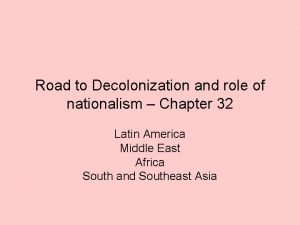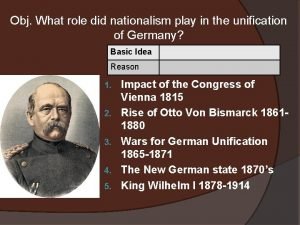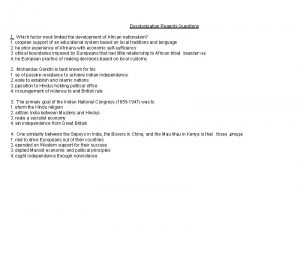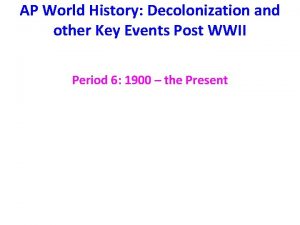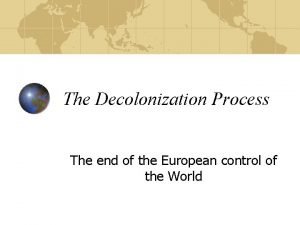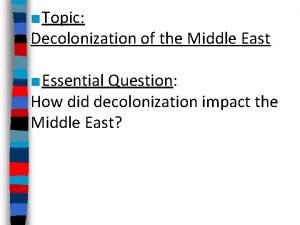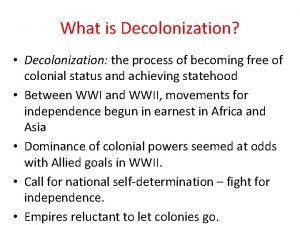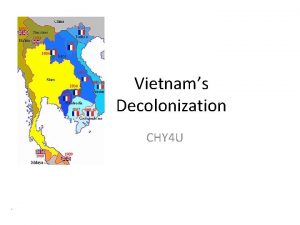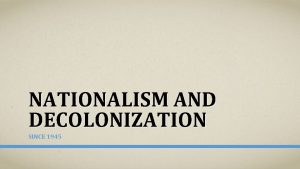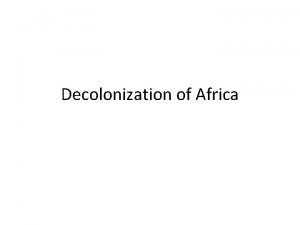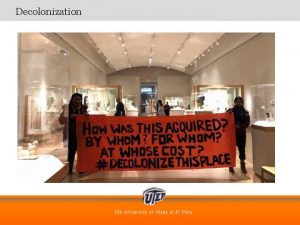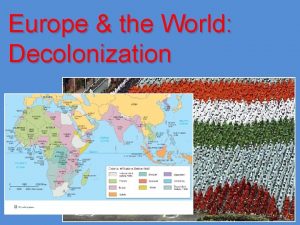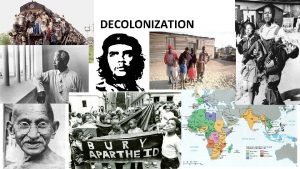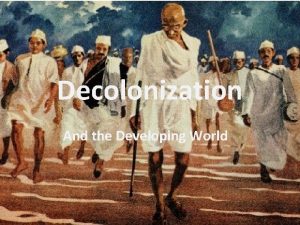Road to Decolonization and role of nationalism Chapter








- Slides: 8

Road to Decolonization and role of nationalism – Chapter 32 Latin America Middle East Africa South and Southeast Asia

What was the nature of British imperialism in India? • Britain developed the infrastructure of India in the form of harbors, railroads, modern cities, and cotton and steel mills. • Independence was granted gradually with full independence coming only after World War II. • English rule provided many benefits. English became the common language for a land with many different languages. English rule also created Westerneducated professionals and bureaucrats who were to become the leaders of the independence movement.

What was the role of Mohandas Gandhi’s in the Indian independence movement and the direction of that movement after World War I? • • • Gandhi’s teachings of nonviolent protest and class unity found receptive Indian audiences. He combined Hindu and Christian ideologies and rejected industrialization in favor of home manufacturing. As a result, Britain slowly granted concessions to the Indian National Congress and Muslim League, particularly in internal affairs. British weaknesses during World War II, along with Indian contributions to the war effort, resulted in British promises of independence after the war. When a postwar split between Muslims and Hindus divided the movement, the Muslims broke away to form the Pakistan. The British viceroy, Lord Mountbatten, declared independence for India and Pakistan in August 1947.

Describe the movement for independence in India prior to the rise of Mohandas Gandhi. • • British colonialism, the soaring Indian population, and the rigid class structure of Indian society were the major factors influencing the independence movement. British racial attitudes particularly offended the better-educated Indians. In 1885, that professional class founded the Indian National Congress, which petitioned the government for reforms rather than for independence. During World War I, Indian support for Britain led the Home Rule League to ask for more radical reforms, such as Indian control of internal affairs. Britain responded with some minor concessions toward self-rule. A return to conservative policies after the war caused violent uprisings by Indians who believed that British concessions were an attempt to postpone Indian independence.

What were some of the factors that led to the growth of movements for African independence? • • • There were several forces that gave rise to independence movements in Africa. First, the education of some Africans received from Christian or Muslim schools, and their exposure to political ideas from the West that emphasized natural rights clearly influenced an African elite to identify their need for independence. They helped create the African National Congress to defend the interests of Africans. Many Africans participated as soldiers in World War II and returned to Africa with new radical ideas that favored liberation. World War II demands for labor, conscription, and food exports, together with Allied ideals of liberation and freedom, convinced many Africans of the need for radical change.

What was the nature of “classic colonialism” in Africa before World War II. And what changes did European rule bring to Africa? • • • Colonialism received a boost at the end of the First World War when the Allies won control of German colonies. Europeans invested heavily in colonial railroads, harbors, and mines, which enormously increased the output and value of agricultural and mining commodities. However, forced labor and urbanization increased malnutrition and disease. Racial segregation in housing, health care, and public accommodations became more pronounced. Labor demands and the widening disparity between the wealthy and the poor embittered many Africans, causing a growth in nationalist movements

What were the circumstances prior to 1911 that triggered the Mexican Revolution? • • Several important factors influenced the events leading up to the Mexican Revolution. Of all the Latin American nations, Mexico was the most affected by three centuries of Spanish colonial rule. There were divisions between Mexicans of Spanish, Indian, and mixed ancestry, as well as deep class divisions between the wealthy and the poor. By 1910, the wealthiest 1 percent of the families of Spanish origin owned 85 percent of all land. The great increase in railroads and other infrastructure benefited only wealthy Mexicans, exacerbating class divisions. The abandonment of traditional Mexican culture by the wealthy class further alienated the Mexican masses. These numerous divisions laid the groundwork for the Mexican Revolution.

How did the World Wars and the emerging world economy affect the internal political situation in Brazil and Argentina? • • • Before the First World War, Brazil produced most of the world’s coffee, cacao, and rubber. However, competition from Asia crashed the rubber export business in 1912 and World War I stopped the flow of imports and lessened the flow of exports. Some immigrants started their own manufacturing of textiles and household goods. In Argentina, the middle class got the secret ballot and suffrage in 1916 and elected a liberal president but Argentina likewise had a coup in 1930 by the military. In 1943, another military coup was staged by Juan Perón. – The coup leaders were corrupt and wanted nothing less than the conquest of South America. – Perón, however, reinvented himself as a champion of the downtrodden urban workers and his wife, Eva Perón, became the champion of women, children, and the poor. – Juan Perón won the presidency in 1946 and created a popular dictatorship.
